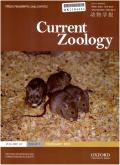Extending the social cohesion hypothesis: Is group social structure associated with dispersal in yellow-bellied marmots (Marmota flaviventer)?
IF 2
2区 生物学
Q2 ZOOLOGY
引用次数: 0
Abstract
Dispersal is an important individual decision which may influence individual fitness as well as population viability. The social cohesion hypothesis posits more social individuals remain at home, which is supported by prior work across taxa. However, how the sociality and connectivity of the group an individual resides in – their group social structure – relates to dispersal decisions has not been explored. We extend the social cohesion hypothesis to predict individuals residing in more social groups would remain at home, and we quantified the affiliative and agonistic social network structure of female yellow-bellied marmots (Marmota flaviventer), a facultatively social ground-dwelling squirrel, where about half of all females disperse. Using mixed-effects models we found no support for the hypothesis that affiliative group structure explained any variation in a marmot’s decision to disperse. We did find marmots in groups with less agonistic centralization (around one or few individuals) were less likely to disperse. The former finding may result from limited ability to perceive group structure while the latter may reflect individuals in less agonistically centralized groups are less likely to be reproductively suppressed. These results suggest individual dispersal decisions are more impacted by individual sociality and not that of their social group. Thus, the social cohesion hypothesis may not scale to the level of the group. Further work is required to determine whether dispersal decisions in obligately social species are influenced by group social structure.扩展社会凝聚力假说:黄腹旱獭(Marmota flaviventer)的群体社会结构与散布有关吗?
散居是一个重要的个体决定,可能会影响个体的适应性和种群的生存能力。社会凝聚力假说认为,社会性更强的个体会留在家中,这在之前的分类群研究中得到了支持。然而,个体所处群体的社会性和连通性(即群体社会结构)与散布决定之间的关系尚未得到探讨。我们扩展了社会凝聚力假说,预测居住在更多社会群体中的个体会留在家中,并量化了雌性黄腹旱獭(Marmota flaviventer)的附属性和对抗性社会网络结构。通过使用混合效应模型,我们发现隶属群体结构无法解释旱獭驱散决定的任何变化。我们确实发现,在较少争斗集中(围绕一个或几个个体)的群体中,旱獭的驱散可能性较低。前一个发现可能是由于对群体结构的感知能力有限,而后一个发现可能反映了在较少激动集中的群体中的个体较少受到生殖抑制。这些结果表明,个体的分散决定更多地受到个体社会性的影响,而不是其社会群体的影响。因此,社会凝聚力假说可能无法扩展到群体水平。要确定强制性社会物种的扩散决定是否受群体社会结构的影响,还需要进一步的研究。
本文章由计算机程序翻译,如有差异,请以英文原文为准。
求助全文
约1分钟内获得全文
求助全文
来源期刊

Current Zoology
Agricultural and Biological Sciences-Animal Science and Zoology
CiteScore
3.20
自引率
9.10%
发文量
111
审稿时长
6 weeks
期刊介绍:
About the Journal
Current Zoology (formerly Acta Zoologica Sinica, founded in 1935) is an open access, bimonthly, peer-reviewed international journal of zoology. It publishes review articles and research papers in the fields of ecology, evolution and behaviour.
Current Zoology is sponsored by Institute of Zoology, Chinese Academy of Sciences, along with the China Zoological Society.
 求助内容:
求助内容: 应助结果提醒方式:
应助结果提醒方式:


